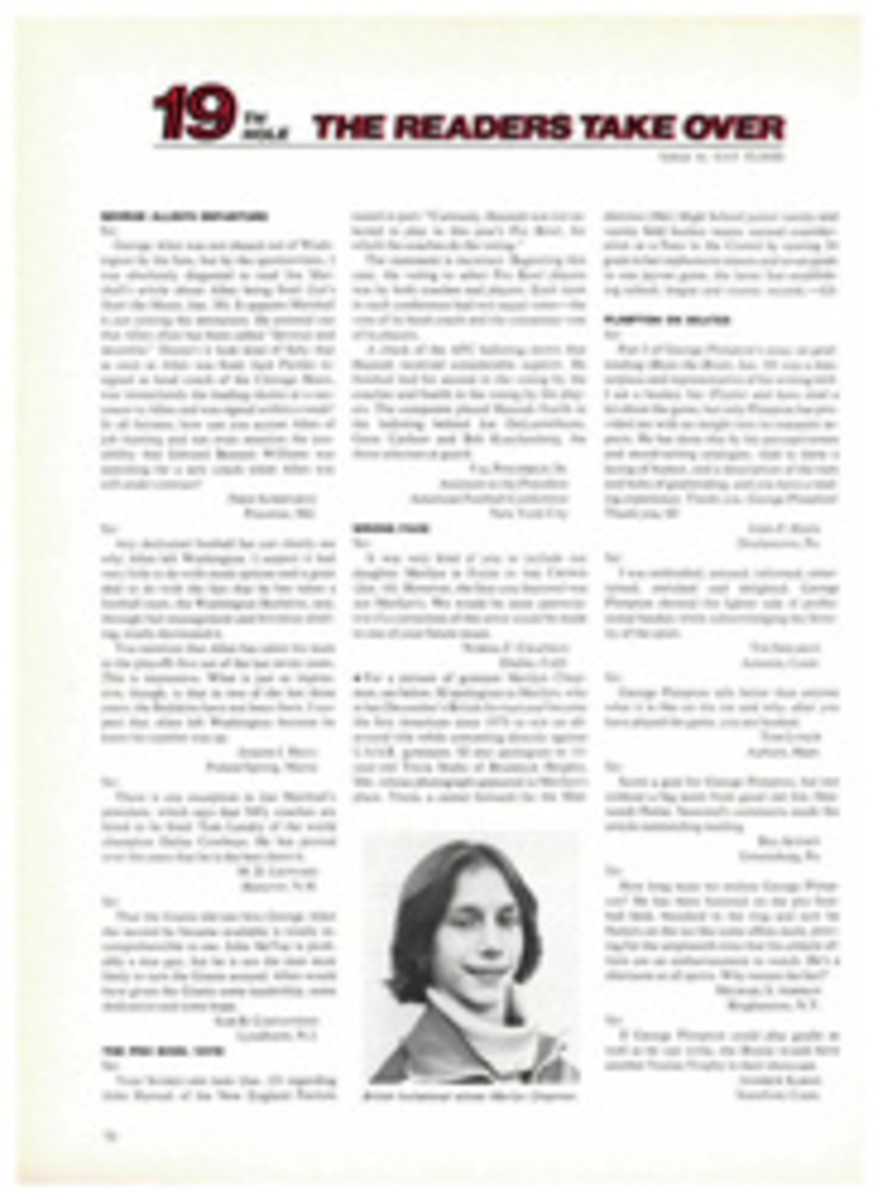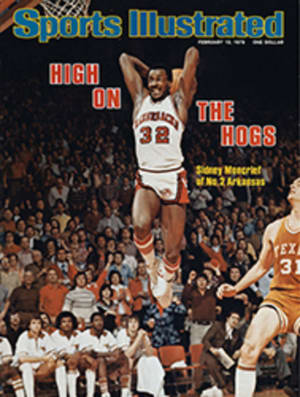
SCORECARD
CHAMPION BY COMMITTEE
From Barons Court in London, headquarters of the International Tennis Federation, comes word that the ITF plans "to make its own formal judgment on the matter" of which man and woman each year deserves the title "world champion." For more than 60 years this issue has been left to journalists, computers and point systems, but now the ITF has created two committees to do the official anointing, starting in 1978. Don Budge, Fred Perry and Lew Hoad will pick the man; Margaret Court, Margaret du Pont and Ann Haydon Jones will pick the woman.
However, the formal judgment of Bob Briner, executive director of the Association of Tennis Professionals, is that the ITF's thinking is as fuzzy as a new ball. Briner believes that, for the men at least, the winner should be determined by the Colgate Grand Prix Masters tournament, which "brings together the top eight players in the world based on their court results during year-round, worldwide, all-surface competition.
"Of all the tennis organizations, the ITF has less to do with big-time tennis than any other," says Briner. "The ITF could close up tomorrow and the pro game would go on without missing a beat.... Saying they are going to name an official world champion is roughly akin to the AAU announcing that it is going to name the most valuable player of the National Basketball Association."
In other words, the selection of the world champs will continue to be chaotic and controversial. But then why should it be any different from most other aspects of tennis?
COLD FIGURES
Here's a sports problem that is included in an article on puzzles in, of all places. The Farmer's Almanac for 1978.
A five-team hockey league lost most of its records before the end of the season. A statistician was hired and told to reconstruct the stats—games played, won, lost, tied; season points; goals scored, goals given up—from the few details available to him. The statistician knew that each team was scheduled to play every other team once and, as is customary in hockey, a team earned two points for a win, one point for a tie, no points for a loss. Otherwise, all he knew was:
•The Canadiens had not lost a game.
•The Bombardiers had scored five goals and had given up two.
•The Algonquins and Delawares had both played their four games, the Canadiens had played three, and the Esquimaux two.
•The Algonquins had a season total of five points, the Canadiens and Delawares three each, the Esquimaux none.
•The Algonquins had scored seven goals in their four games and had given up one. The Esquimaux had scored two, given up six.
•The Delawares had scored five, but their goals-against total was missing.
•The Canadiens had given up four goals, but their goals-scored total was missing.
From these fragmentary data the statistician not only had to reconstruct the standings, but he also had to determine which teams had played which so far, and what the results and the scores of each game had been.
He did it.
Can you?
PGA BELOW PAR
Golfer Lee Trevino complains that the pro golf tour is one of the few sports organizations that does not provide full-time medical services to its participants.
"Say you get a little hitch in your back on the practice tee 15 minutes before you're supposed to tee off," says Trevino. "You're naturally worried about it, but what can you do? It's not like you can say, 'Send in the reserve. I'll catch him on 15.' You go out on the first tee on Thursday or you're out."
MARYLAND BEAUTY
A new film version of Black Beauty, Anna Sewell's classic 1877 novel, was serialized for five nights on TV last week. Universal Studios took a few liberties with the story, such as changing the setting from England to Maryland, which is traditional—and very beautiful—horse country. When Beauty is forced to pull a city cab, the city is supposed to be old Baltimore.
However, all the filming was done in Kentucky during the fall. And what is supposed to be pre-1900 Baltimore is actually Paris, Ky. with its parking meters removed.
BIORHYTHMICAL WARFARE
A basketball coach in New Jersey is using a strategy that may make pep talks obsolete. Coach Ken Leary of Pleasantville High claims his team is 13-2 because, following the suggestion of his athletic director, Joe Clements, he has been charting his players' biorhythms. By using printouts from the school's computer. Leary claims to know who will be hot and who will be cold even before warmups. "They use these things with airline pilots, so it makes sense to use them for something like a basketball team," he said. "From the results so far, I honestly believe biorhythms are as good a coaching tool as any other."
Until last week the most disadvantageous set of biorhythms in the nation must have belonged to the Stockbridge (Wis.) High School basketball team. Stockbridge had lost 90 consecutive games dating back to November of 1972. The Milwaukee Bucks had treated the team to a night on the town just to keep its spirits up. But after a five-year valley, Stockbridge's biorhythms finally hit a peak last Tuesday, and the Indians beat JFK Prep from St. Nazianz 45-35. The players gleefully cut down the nets and flashed the score on the scoreboard for half an hour after the game. Governor Martin Schreiber has been asked to proclaim a Stockbridge Day in Wisconsin.
AND THEN THERE WAS ONE
The University Lake high school girls' basketball team from Hartland, Wis.—yep, that state again—was playing Shoreland Lutheran High in Kenosha recently. Four University Lake players were out sick with the flu, leaving only five to suit up. Still, the Lakers led 22-11 at halftime.
Soon, however. University Lake started to recede. Mary Allen fouled out, and the Lakers finished the third quarter with four players and a 25-16 lead. Rita Landis sprained an ankle and departed early in the fourth quarter. Sandy Saeger fouled out with less than three minutes left. And Ann Yeomans fouled out with about one minute to go; but her team still led 33-25. That left Laura Merisalo, who had four fouls, to play against five Shore-land opponents, a problem on defense certainly but also a headache when she had to inbound the ball (she tossed it to an opponent and tried to steal it back).
Laura gave up four points in that final minute, but University Lake still won 33-29.
THE WHITTIER CONNECTION
When Gordon Jones, turf writer and handicapper for the Los Angeles Herald Examiner, arrived at Santa Anita last Thursday, there was a message: "Some guy who says he's Richard Nixon wants you to call him." Knowing that the ex-President seldom, if ever, calls reporters, Jones dialed the number skeptically.
"This is Richard Nixon," said a voice hesitantly. "I am calling to say I think you wrote a very sensitive piece about George Allen in today's paper." Jones had told of meeting Allen when the handicapper was track captain at Whittier College and Allen was football coach. It was one of the few complimentary stories to appear about the former Redskin coach, a longtime friend of Nixon's, since he had been named to take over the Rams.
The reporter reminded the ex-President that they had met previously, that his father had been president of Whittier when Nixon was a trustee. Nixon then began to philosophize on coaching and leadership. On Vince Lombardi: "A lot of [his players] thought he was a mean S.O.B. and they cussed him for the way he drove them. But they won with him...." On George Allen: "He is tough and players don't always love a coach for that. But a coach doesn't have to be loved to win. He has to be respected.... He isn't much for a pat on the back for reporters. He's more golly and gee and a milk shake, and I don't think most members of the press are that way."
Which brought him to, "What I want to know is why a nice Whittier College graduate like you is covering the horses. I think you might want to move up from horse races to political races.... It's all right to cover the horse races, but don't bet on them because you can't beat them."
Jones, a former USC journalism teacher who is billed by his paper as Professor Gordon Jones, pondered the advice—for all of five seconds—before rushing to the press-box pari-mutuel window. He won that bet and the next and the next—a $263 exacta—and finished with more than a $1,000 profit for the day to go with his exclusive story.
THE LAST JAM
If we ignore the mythical claims in behalf of Abner Doubleday, there remain only three North Americans who invented a sport from scratch. One was Dr. James Naismith, the Canadian who conceived basketball. The second was William G. Morgan, who created volleyball in Holyoke, Mass. The third died last week in Encino, Calif. at the age of 74. His name was Leo Seltzer; the game he invented was Roller Derby.
Seltzer was a theatrical and sports entrepreneur, a marvelous American original. For a time he promoted Walkathons, with such unknowns as Frankie Laine and Red Skelton serving as emcees. Then he hit upon his roller skating scheme in Chicago in 1935. It was an instant success and with the help of television enjoyed two great boom periods after the war.
The Derby is moribund now, a fact that distressed Seltzer greatly. He always hoped that his creation, which like pro wrestling tended to be more show biz than sport, would thrive as a legitimate athletic contest. Seltzer was a superb, dispassionate businessman, a successful land developer and a partner in the Roller Derby Skate Co., with $30 million in annual sales, but his family constantly had to talk him out of selling out and investing the works in a new, legit Roller Derby League. One of the last calls he made was to Sonny Werblin, an old show biz pal who is the new head of Madison Square Garden, urging Werblin to join with him in starting a 100% honest Derby League.
In a sense, Leo Seltzer suffered the only Naismith complex in history. It was never enough that his neat little game entertained millions of people. The hokier—and more successful—it grew, the more he despised what he had wrought. He longed to leave the world a real sport.
HOCKEY STILL SLIDING
There is a move afoot to change the format of the National Hockey League All-Star Game from a contest between the two divisions to a three-game series between a team of NHL stars and a Soviet team. The hope is that such a series will attract the network TV contract the league desperately needs.
That's O.K., but rather than dwelling on the All-Star Game, which matters to hardly anyone, hockey might do better to have a face-off with its more pressing problems. Games between the six good teams and 12 bad ones lead to mismatches and reduced attendance. Also. NHL scheduling ignores its traditional and geographic rivalries. The underlying problem is a lack of cohesiveness. The 18 NHL owners are taking 18 separate paths—and this is not the road to television money.
ILLUSTRATION
THEY SAID IT
•Lou Carnesecca, St. John's basketball coach, asked about Villanova freshman Forward Alex Bradley: "He's the most unheralded best freshman I ever heard of. Does that sound right?"
•Richie Ashburn, former Philadelphia. Phillie outfielder, after getting 158 votes in the balloting for enshrinement in the Baseball Hall of Fame this year (he got only six votes the first year he was eligible): "I'm flattered that so many baseball people think I'm a Hall of Famer, but what's hard to believe is how 150-plus people have changed their minds about me since I became eligible, because I haven't had a base hit since then."

